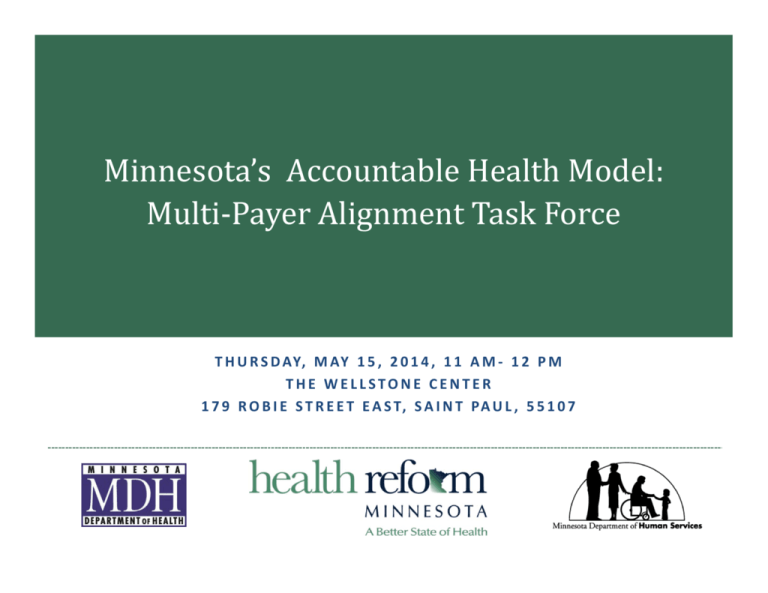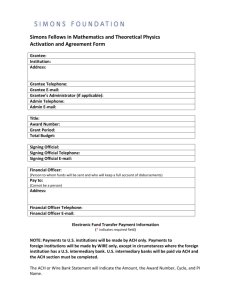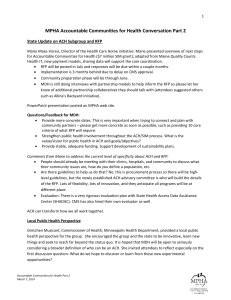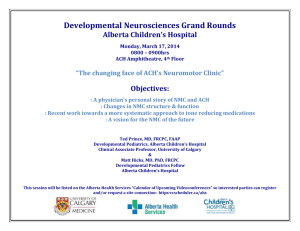Multi-Payer May 15 Presentation
advertisement

Minnesota’sAccountableHealthModel: Multi‐PayerAlignmentTaskForce T H U R S D AY, M AY 1 5 , 2 0 1 4 , 1 1 A M ‐ 1 2 P M THE WELLSTONE CENTER 1 7 9 R O B I E S T R E E T E A S T, S A I N T PA U L , 5 5 1 0 7 Agenda • Welcome and Overview of Agenda • Update on the Accountable Communities for Health Subgroup • Data Analytics Discussion • Next Steps Agenda • Welcome and Overview of Agenda • Update on the Accountable Communities for Health Subgroup • Data Analytics Discussion • Next Steps Accountable Communitiesfor Health Community Based Governance Structure Adapted from Maine Quality Counts 4 AccountableCommunitiesforHealth(ACH) SubgroupActivities Convene members in February – April, 2014 to: • Provide guidance and advice in setting strategies to raise awareness of the ACH vision across Minnesota that will create community readiness for innovation in health and health care system redesign • Provide advice on soliciting and receiving input from diverse stakeholders and communities regarding the ACH approach and applying that input to program planning as appropriate • Develop recommendations for selection criteria and recommendation of ACHs in collaboration with existing advisory groups and the SIM leadership team by the end of March AccountableCommunitiesforHealth(ACH) SubgroupMembers Alex Alexander MPA, MBA ‐‐ Beacon Group, SE MN, Project Management Office, Mayo Clinic Catherine Brunkow, RN ‐‐ HCMC, Community Care Team, Hennepin County Human Services & Public Health Dept Catherine Vanderboon, RN, PhD ‐‐ Community Care Team, Mayo Clinic, Gina Nolte ‐‐ Partnership for Health and CTG, Clay County Public Health Heidi Favet, CHW ‐‐ Essentia Health Ely Community Care Team Jan Malcolm ‐‐ Courage Kenny Center, Allina Health Jennifer DeCubellis and Ross Owen ‐‐ Hennepin Health Jim Przybilla ‐‐ PrimeWest Joanne Foreman, RN, BAN ‐‐ Institute For Clinical Systems Improvement, Accountable Health Community Kathy Gregersen ‐‐ Mental Health Resources Center Kevin A. Peterson MD, MPH, FRCS, FAAFP – Dept of Family Medicine & Community Health, Univ of MN, Minnesota Academy of Family Physicians Kristin Godfrey, MPH ‐‐ HCMC, Community Care Team, MPHA Roxanne King, CHW ‐‐ NorthPoint Health and Wellness Sarah Keenan RN, BSN ‐‐ Bluestone Susan Severson ‐‐ Stratis Health AccountableCommunitiesforHealth(ACH) SubgroupActivities ACH Advisory Subgroup will meet three times: • February 28 • ACH Goals • March 14 • • • • • Eligible applicants Populations to serve Leadership structure Care Coordination Team Population based prevention • March 28 • • • • Sustainability planning Advancing health equity ACO participation Putting it all together Whocanapply? MN SIM Project Narrative Language: Eligible applicants include: provider, a tribe, a community or consumer organization, a county, and/or other non‐profit entity, such as a health plan or a consortium with a designated fiscal agent We asked: Should there be limits on who can be the applicant? Whocanapply? ACH Subgroup Feedback: Leave this as broad as possible to allow for innovation Be clear that ACO does not need to be the lead applicant but must be at the table. Ensure that partners are identified in a meaningful way Do not exclude for profit organizations as applicant Populationtobeserved MN SIM Project Narrative Language : • Population is broadly defined such as, geographical, defined by patient population, or health needs of the community, high resource use in a smaller segment of the communities population, or a specific population such as a high rise or a virtual population of members. • Intentional efforts should be made to reach marginalized and underserved communities. We asked: Who must participate, should there be limits? Populationtobeserved ACH Subgroup Feedback: • Keep range of options open • Do require a clear definition of the population to be served • Focus on largest population with unmet needs. • Access to data on the population to be served should be essential, but acknowledge that this could be a challenge depending on how the population is defined HowtoGetStartedtoIdentifyPopulation, BuildOnCommunityBasedData • Build on local public health or hospital community • • • • • assessment. Check out your local public health agency. Each public health agency needs to complete their community health assessment by February of next year. Use SHIP Community Assessment data. Health Systems Data or Health Plan Data. Workforce or community collected data. CDC / BRFSS: Behavioral Risk Factor Surveillance System. LeadershipStructure MN SIM Project Narrative Language : • Be guided by a community‐led oversight body / leadership team. • Demonstrate significant community responsibility for strategies and priorities • Focus on local solutions and move toward inclusion of services beyond health care to create a greater degree of accountability across health care, long term services and support, public health, mental health, chemical health, oral health, and social services We asked: • Does a community led leadership body need to be in place ahead of time, before the grant? • What should the requirements be for the makeup of the community led oversight body? LeadershipStructure ACH Subgroup Feedback: • Ensure that the community has a voice within the decision‐making structure, not simply “advisory” • Identify a leader to facilitate communication and sustain project’s focus • Demonstrate commitment of partners in a meaningful way • Look to innovative ways to evaluate commitment of partners (e.g. interviews) HowtoGetStartedinDevelopingaLeadershipStructure EngageCommunityMembers,“ReachOut” Goal: ACH’s will engage community members and stakeholders to establish priorities to impact health goals, build partnerships that will integrate and coordinate care within their communities. • Engage community members (citizens) • Engage providers, community / local public health, community or cultural organizations, schools, tribes, faith based organizations, patient advocacy groups, worksites, employers, housing, social services, long term services and supports, behavioral health and other medical or non‐medical groups who care for or provide services for all aspects of an individuals health • Workplace / school wellness teams, people participating in “health” • Local Public Health is Required to Participate • Clinics /Hospitals • ACO Partners Care Coordination Team MN SIM Project Narrative Language: Must build on and integrate clinic and community resources including social services, local public health, home visiting, long term services and supports, behavioral health and other community partners. We asked Is there a minimum capacity that the Care Coordination Team needs to be able to demonstrate? What would that look like? Care Coordination Team ACH Subgroup Feedback: • Be clear about the distinction between “care coordination team” as a hub of care for a patient involving coordination between clinic‐ and community based resources and services versus traditional care coordination within heath care system. • Developing a community based system / model of care coordination. PopulationBasedPrevention MN SIM Project Narrative Language: • Must reflect local needs assessments conducted by local public health, local hospitals or other entities • Link with other local public health initiatives. We asked: • Should a community assessment plan serve as the basis for any ACH? What if it’s too broad and doesn’t capture the population proposed? • What measures should communities be considering? Population Based Prevention ACH Subgroup Feedback: • Community Assessments are a good source of data but should not be the only basis for focusing efforts • Partners should arrive at a shared definition of health for the community and providers, and consensus regarding the desired health outcomes AdvancingHealthEquity MN SIM Project Narrative Language: A competitive RFP to expand up to 15 ACH’s with a priority on communities in areas with a lower level of ACO penetration, greater disparities, and higher health care needs We asked: What ways should we consider advancing health equity in the ACHs? Advancing Health Equity ACH Subgroup Feedback: • Keep the definition of health equity broad • Recognize that it may be difficult for communities with fewer resources to apply and consider methods to build community capacity • Consider a phase‐ in approach to allow funding for some groups with less capacity up front to do planning SIM Testing/Measurement MN SIM Project Narrative Language: Must work with SIM evaluation staff and/or contractors to develop and implement process and outcome measures for the project. We asked: • How should the ACH be measured? • Is the focus on process, quality of life, patient centeredness tools, community partnership ? • How do we evaluate intangibles that affect peoples’ lives? SIM Testing/Measurement ACH Subgroup Feedback: • Be clear about what the state will be measuring vs. what ACHs will be expected to measure themselves • Try to balance measurement on elements pertinent to all parts of triple aim, not just cost. Patient experience and population health need to be included. • Look at quality of life measures (e.g. “healthy days”) and social determinants of health • Provide technical assistance regarding data sources to (potential) applicants/grantees ACOParticipation MN SIM Project Narrative Language: Include at least one ACO that provides primary care services to a threshold percentage of the community’s population. We asked: • What is the threshold for the number of people or % of the population covered? • What if there are no ACO or ACO‐like entities serving the proposed population? ACOParticipation ACH Subgroup Feedback: • State needs to be clear about what “ACO” means in the context of ACH • Since few healthcare organizations yet have a substantive proportion of their patients in a risk‐based arrangement to act like a ACO consider a step‐wise process • Ask applicants to focus on how they are working towards shared savings/shared risk arrangements • Payers shouldn’t be the only drivers – ensure that community is setting goals too Sustainability MN SIM Project Narrative Language: • Develop infrastructure to support implementation of the ACH including development of a sustainability plan, and participation in rapid‐cycle evaluation of the model. • Must develop a plan that identifies sources for future funding of ACH. We asked: • How is sustainability defined and what does it include? Sustainability ACH Subgroup Feedback: • Financial sustainability may be very hard to demonstrate in such a short period of time • It will probably take longer than the grant period to shift financial incentives • Payers should not be the only drivers • State should select metrics carefully and realistically General Feedback ACH Subgroup Feedback: • Prepare a glossary of terms to accompany the RFP • Provide technical assistance to smaller communities and organizations to ensure inclusivity • Reach out to non‐traditional groups, share tools • Communicate details as soon as possible to allow adequate time for prep ACHCommunityEngagementGoals NextSteps The primary goals of the community engagement process are to: • Raise awareness of the ACH vision and other service delivery with a patient centered, coordinated integrated approach • Create community readiness for innovation in health and health care system redesign, delivery and payment; • Receive input from diverse stakeholders and communities regarding the ACH approach, including ACH structure and governance. CommunityEngagement,NextSteps • Communication through a variety of methods, webinars, • • • • • newsletter, and website. Resources dedicated to identifying and engaging underserved communities. Regional presentations. Events already scheduled. Do you have an event already planned with community members? Let us know. Connect on our website at http://mn.gov/sim and Select Request a Speaker TentativelyRevisedACHGrantTimeline • ACH Advisory Subgroup Meetings thru April, 2014 • Contract with Community Care Teams Late Summer • • • • • 2014 Statewide Community Engagement through Summer, 2014 and ongoing Post competitive RFP September 1, 2014 RFP review mid‐October, 2014 Contract finalization Nov./Dec., 2014 Implementation begins in January 1, 2015 TaskForceDiscussion– Accountable CommunitiesforHealth ACH Subgroup member impression: • Jim Przybilla Q & A MoreInformation • • Visit www.mn.gov/sim • Sign up for email alerts at the website • Request speakers at www.mn.gov/sim • Email sim@state.mn.us Agenda • Welcome and Overview of Agenda • Update on the Accountable Communities for Health Subgroup • Data Analytics Discussion • Next Steps DataAnalyticsforIntegratedHealthPartnerships: ThePayerPerspective– AttributionandRiskScores • Majority of respondents use data to attribute members. Different approaches to such attribution include: • Member choice Utilization history Claims data (e.g., provider seen most often) Provider/member location Majority of respondents provide risk scores or other health risk information aggregated at the patient and population levels. Itasca Medical Care’s information’s aggregate at the provider level only. St. Mary’s Health Clinic and Hennepin County do not provide or receive risk scores or other health risk information. MHAG makes no mention of calculation of risk scores for individuals or populations. DataAnalyticsforIntegratedHealthPartnerships: ThePayerPerspective– DataExchange • All respondents are exchanging data. Majority of respondents are exchanging clinical, quality, utilization, attribution, gaps in care, and cost of data in addition to other types of data. St. Mary’s Health Clinic is providing financial, pharmacy and eligibility data. MHAG works with MNCM, which exchanges patient counts by health plan to develop quality measures. • Payers with one‐way data exchange: • Payers with two‐way data exchange: • Prime West, Medica, and Ucare. HealthPartners, Hennepin County and Minnesota Health Action. Payer with both a one‐way and two‐way data exchange: BCBS DataAnalyticsforIntegratedHealthPartnerships: ThePayerPerspective‐ DataUsage • • Data used to better coordinate care and assist quality initiatives. Care coordinators and quality staff have access to, and utilize, the data. Additional: PrimeWest financial personnel have access to data. Hennepin County data warehouse staff and leadership have access to data. MHAG insurance providers and health plans have access the data. • Respondents report using a mix of tools to exchange data. UCare, BCBS, HealthPartners, and Hennepin County utilize a provider portal. A portal is in development at Itasca Medical Care. PrimeWest, BCBS, and Hennepin County utilize direct data feeds. Medica, BCBS, Hennepin County, Itasca Medical Care, St. Mary’s Health Clinic, and MHAG utilize spreadsheets. BCBS, Hennepin County, and Itasca Medical Care also utilize paper reports. DataAnalyticsforIntegratedHealthPartnerships: ThePayerPerspective– TimelinessofData • Near time data, specific to member care, provided by PrimeWest, Medica, BCBS, and Itasca Medical Care exchange. • Weekly reports provided by BCBS and Hennepin County. • Monthly reports provided by PrimeWest, UCare, HealthPartners, and Hennepin County. • Quarterly reports provided by PrimeWest, UCare, BCBS, HealthPartners, and Itasca Medical Care. DataAnalyticsforIntegratedHealthPartnerships: ThePayerPerspective– DataFeedbackfromMarketPayers • Medicaid only: • Hennepin County and Itasca Medical Care • Medicaid and Dual Eligible (Medicare / Medicaid): • PrimeWest • Medicaid and Medicare: • Ucare • Commercial fully insured, commercial self‐insured and Medicaid: • Medica and BCBS • Commercial fully insured and self‐insured, Medicaid and Medicare: • HealthPartners DataAnalyticsforIntegratedHealthPartnerships: ThePayerPerspective‐ InternalandExternalReporting • Four respondents use dashboards, reports, and scorecards to share summary, patient information, and aggregate partner performance with internal care coordinators and staff. • Five respondents share global outcomes and programmatic results, externally through reports, dashboards, and task forces/committees. • UCare uses a licensed software application to share detailed patient‐level risk scores, diagnoses, and utilization information with internal and external care coordinators. DataAnalyticsforIntegratedHealthPartnerships: ThePayerPerspective– ReportsfromClaimsorAdministrativeData • • Medica, BCBS, HealthPartners, Hennepin County, and Itasca Medical Care provide a standard set of reports for every provider group. Seven respondents customize reports by provider group. PrimeWest, Medica, BCBS, Hennepin County, Itasca Medical Care, and St. Mary’s Health Clinic provide static reports by email and/or mail. UCare, HealthPartners, and Hennepin County provide an online portal with standard reports views. PrimeWest, BCBS, HealthPartners, and Hennepin County provide an online portal with customizable views. UCare, BCBS, HealthPartners, and Hennepin County have an online portal with access to raw data. BCBS and HealthPartners also provides a direct data feed to EMR. DataAnalyticsforIntegratedHealthPartnerships: ThePayerPerspective– RequestedInformation • Three respondents are often asked for data that they cannot provide due to State privacy laws, HIPAA, or provider contract provisions. • UCare and HealthPartners noted requests for code level detail and granular data that should be seen in the proper context. DataAnalyticsforIntegratedHealthPartnerships: ProviderView:DataNeededtomanagepatient&populationhealth • The majority of responders listed detailed member data including: Cost of care, utilization, and care plans. This allows providers to understand patient experience, within and outside system of care, to manage cost and improve quality. • Multiple responders want information on health outcomes/quality for clinics and providers to inform areas where clinics and providers are not achieving benchmarks. • A few responders noted that timely data should be regularly reported. DataAnalyticsforIntegratedHealthPartnerships: ThePayerPerspective 1. What were your general impressions of the homework results? 2. What is our goal? Do we agree that the goal is greater alignment of data for providers? 1. If so, what areas are important to align? 2. What are the areas where flexibility in customization should occur? 3. Thinking beyond alignment, what are the types of information that providers need to participate in these arrangements and what can payers do to ensure that providers have access to this information? Agenda • Welcome and Overview of Agenda • Update on the Accountable Communities for Health Subgroup • Data Analytics Discussion • Next Steps ContactInformation • Multi‐Payer Alignment Task Force • Garrett Black (garrett_e_black@bluecrossmn.com) • Jennifer Blanchard, (jennifer.blanchard@state.mn.us), DHS • Diane Rydrych (Diane.Rydrych@state.mn.us), MDH Facilitation Team • Dianne Hasselman (dhasselman@chcs.org) • Diane Stollenwerk (diane@stollenwerks.com) • Shannon Kojasoy (shannonkojasoy@gmail.com)





